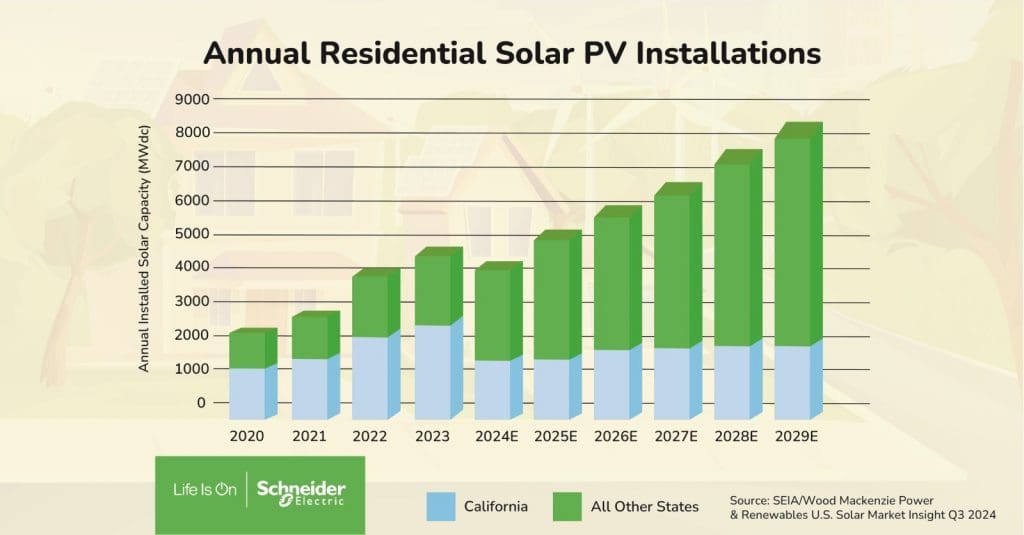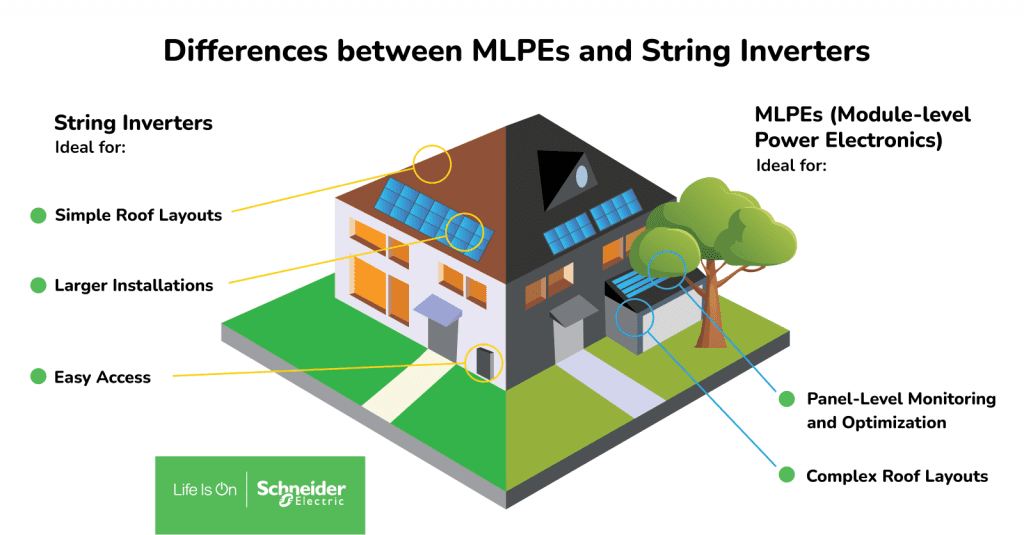With the increasing desire to drive down energy bills and use renewable energy sources, many people are opting to introduce solar power as a means to both generate and consume energy.

With these rapid changes transforming the way many of us consume energy, homeowners will come to expect electricians and contractors to guide them on their best options for solar setups.
Part of this will be helping to educate them on the differences between Module-Level Power Electronics (MLPEs) and String Inverters, systems that are vital in the management of solar power, and advising on which is the best solution for them.
Therefore, it is beneficial for electricians and contractors to understand how they both work in order to suit individual customer needs and ensure an easy installation.
So, what are String Inverters and MLPEs?
String Inverters
Invented prior to the development of MLPEs, string inverters were the go-to traditional technology for converting solar energy into electrical power for our homes.
It is a centralized device that converts direct current (DC) generated by a photovoltaic (PV) array into alternating current (AC), which is used to power home appliances.
In this type of system, solar panels are grouped into strings and connected as a series. The electricity then flows from the panels converting to higher voltage levels as it is passed through.
In this case, multiple strings of solar panels feed into one or more string inverters, installed at ground-level for easy maintenance.
MLPEs
MLPEs are a more recent alternative to string inverters. They consist of either microinverters or optimizers, installed directly onto the solar panel, usually on the roof of a property.
- Microinverters – converts DC to AC at each panel. Each panel functions independently, sending AC power directly into the home.
- Optimizers – maximizes the DC power produced at each panel, which feeds into a centralized inverter where it is then converted to AC, powering the home’s electrical appliances.
Why do both MLPEs and String Inverters exist?
While string inverters are a tried and tested technology, they were known to have limitations, performing poorly in shaded areas.
MLPEs were invented to remedy these issues, offering more flexibility in terms of placement. However, string inverter technology has improved of late and is also able to work well in areas of shading as a result.
But, there are some considerations for contractors to be aware of. For example, as the string inverter system relies on panels being connected in a series, if extreme shading, or a fault were to occur on one panel, the entire performance of the string is impacted.
This is due to the limited number of Maximum Power Point Tracking (MPPT) inputs. An MPPT is a system that ensures the PV array can operate at maximum efficiency based on external conditions.
MLPEs operate at individual panel level so shading that impacts one panel, will not result in a poor performance from the rest. Each output in this scenario has its own MPPT, meaning the system operates in a more efficient way, despite external factors.
Other Differences Between String Inverters and MLPEs
- Cost and Installation
Generally, string inverters are more cost-effective, especially for larger homes, as they are made of less components. MLPEs require individual adjustments to each panel so there are more components which drives up costs and makes repairs more complex.
String inverters also take less time to install, which means homeowners can enjoy cost-savings and contractors can move on to the next job quicker.
- MPPT Performance
As highlighted above, while string inverters are now less likely to encounter issues due to shading, thanks to technological advancements, it is true that all panels in one string share a MPPT. Therefore, if one panel is faulty, the entire output is affected.
MLPEs overcome this as each panel has an individual MPPT, ensuring maximum efficiency at all times.
- Accessibility
When a string inverter fails, the complete system shuts down, which can be inconvenient to the homeowner, and can make it harder for the electrician to identify exactly where the issue is on the system. However, as string inverters are typically at ground-level, it is easier to maintain and service them and they are cheaper to repair.
As for a MLPE system, although the malfunction of one unit will not impact the entire system, they are installed at roof-level, which makes it harder to access. This can result in more costly and time intensive fixes for the homeowner and electrician, respectively.
- Design
String inverter systems require careful planning as string sizing and layout must be accurate. As such, these systems work best on simple roof shapes, which can cause difficulties for some electricians when working on projects with more variability in shape and size
MLPEs tend to be more flexible when it comes to fitting complex roof layouts, which means they are easier to fit onto roofs with multiple orientations.
Which one is the better choice?
Today, given the advances in technology and reliability, the choice between a string inverter and an MLPE might not always be so clear cut.
There is not a definitive answer; each have their plus points, and ultimately it depends on the project and which solution the contractor will recommend.
String inverters can be viewed as the most cost-effective and practical solution for everyday homes, given that they are easier to install and maintain.
However, MLPEs seem to offer more in the way of flexibility and optimization. While they are more costly and take longer to install, they can remain operational should a fault occur in one unit.
In the evolving energy landscape, it is important for contractors to understand and be able to educate homeowners on what MLPEs and string inverters are, their differences, and advise them of the benefits of each according to individual circumstances.
Contractors should keep an open dialogue with the homeowner to determine which option is the best fit for their household. In staying informed on the management and delivery of solar power, electricians can offer flexibility and choice, which in turn will make for happy customers.

About the author

Jake Sherry, Senior Sales Application Engineer at Schneider Electric
Jake is a Schneider sales application engineer with over 10 years of experience implementing customer-focused solutions that meet the technical demands of dynamic business environments, contributing to Schneider Electric’s mission of delivering innovative and sustainable energy management solutions.




Add a comment